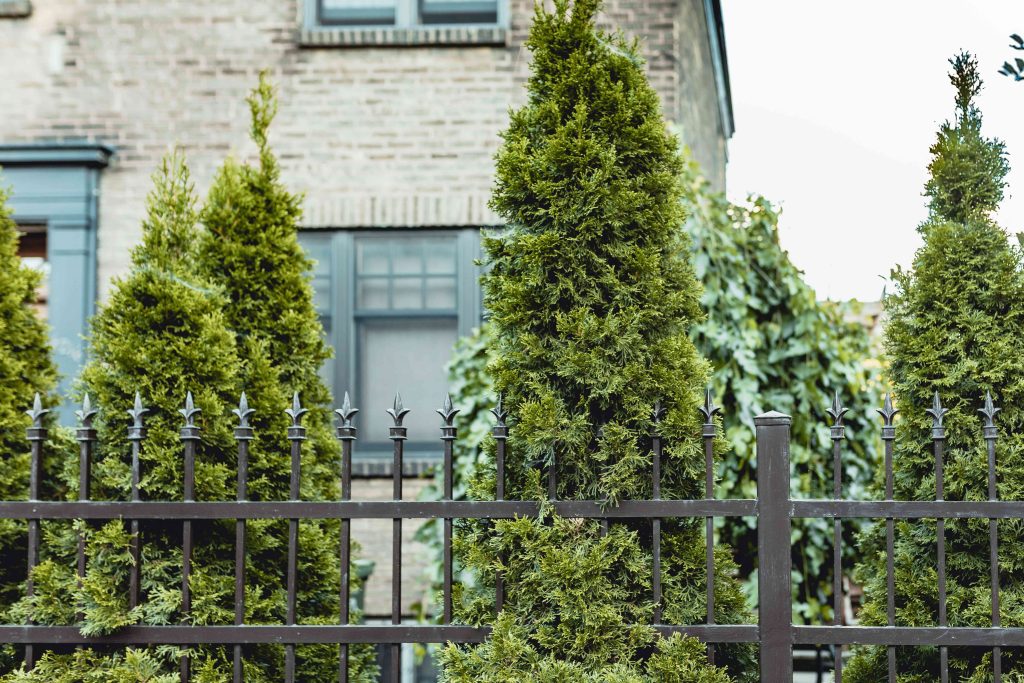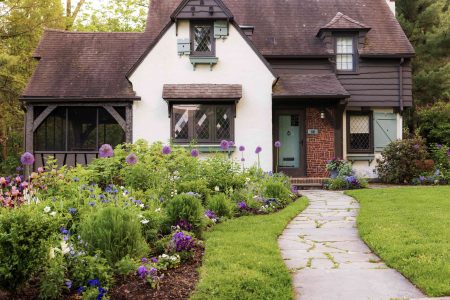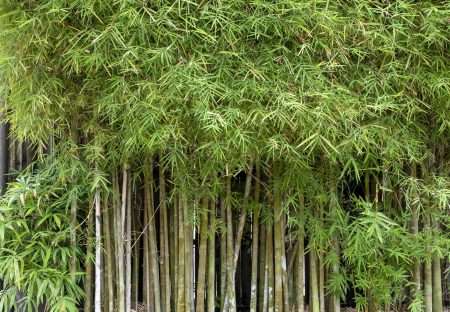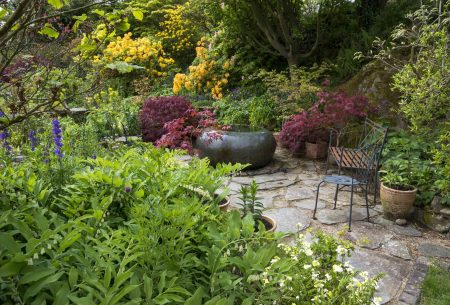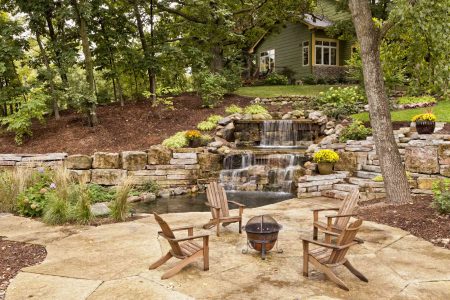Evergreens make wonderful, quick hedges and privacy screens. Some mature quickly into dense hedges and others develop with you, over time. When planting your living screen, do not plant in a straight line. Instead, zig-zag the trees to give a fuller effect and to allow the trees to get air and the sun. This will also help the hedge give with the wind, preventing breakage and wind tunnels.
Choose a couple of your favorite evergreen varieties. It is wise to plant more than one variety of evergreen in a border so that disease and pests will not destroy the whole planting. Take a look at the top 10 choices.
-
01
of 10Boxwood (Buxus)
Long a European favorite, boxwood responds very well to pruning and shaping. Besides making great hedges, boxwoods are a favorite tree for a topiary. The tiny, evergreen leaves remain tidy when clipped. Korean boxwood is proving to be hardier than the English varieties. Prune in late spring, as new growth darkens. Size varies with species and it prefers full sun to partial shade.
- USDA Growing Zones: 6 to 8
- Sun Exposure: Partial or dappled shade
- Soil Needs: Well-drained soil in the 6.8 to 7.5 pH range
-
02
of 10Yew (Taxus baccata)
Yew makes a dense hedge that responds well to pruning. Overgrown yew hedges can often be restored by hard pruning in late winter. Many yews used for foundation plantings remain squat. T. baccata grows to 6 feet tall and 16 feet spread, making it great for hedging. The uniformity of a yew hedge makes a great wall for enclosed gardens. It is a slow-to-medium grower.
- USDA Growing Zones: 2 to 10, depending on the variety
- Color Varieties: Non-flowering; dark green needles and red berries
- Sun Exposure: Sun, partial shade, or full shade depending on variety
- Soil Needs: Well-draining soil with a neutral pH
-
03
of 10Arborvitae Green Giant (Thuja Green Giant)
Arborvitae Green Giant was introduced by the U.S. National Arboretum. You can grow it in almost any soil conditions from sand to clay. It forms a pyramid shape and requires no pruning. It is pest resistant and even deer resistant. For a quick hedge or windbreak, plant these plants 5 to 6 feet apart. For a more gradual hedge, plant 10 to 12 feet apart. These fast-growers can reach a height of 60 feet and a spread of 20 feet.
- USDA Growing Zones: 2 to 7
- Sun Exposure: Full to partial sun
- Soil Needs: Tolerates a range of soils but prefers moist well-drained loams
-
04
of 10Holly (Ilex)
Popular for its glossy green leaves, and bright red berries, hollies look best if kept trimmed and full. Only the females set berries, but you will need a male to cross-pollinate. There are some new varieties that do not require two sexes. Hollies prefer acidic soil and the addition of peat or garden sulfur may be necessary. The American holly is more widely adaptable than English holly. It is a medium grower, reaching a height of 6 to 10 feet and a spread of 5 to 8 feet. Plant hollies 2 to 4 feet apart.
- USDA Growing Zones: 5 to 9
- Color Varieties: Greenish-white flowers and red berries
- Sun Exposure: Full sun to partial shade
- Soil Needs: Well-drained, slightly acidic, fertile soil
Continue to 5 of 10 below. -
05
of 10Firethorn (Pyacantha coccinea)
Firethorn can be a bit unruly, but it still looks striking in the landscape. It is an evergreen with white flowers in spring and orange-red berries from summer into winter and is popular for Christmas decorations. This drought-tolerant plant likes full sun to partial shade. Plant firethorns 3 to 4 feet apart. It is a fast grower and can reach a height of 8 to 12 feet and a spread of 3 to 5 feet. Prune if necessary, after flowering.
- USDA Growing Zones: 6 to 9
- Color Varieties: Small white flowers resulting in orangey fruits
- Sun Exposure: Full sun to partial shade
- Soil Needs: Moist, well-drained soil
-
06
of 10Leyland Cypress (x Cupressocyparis Leylandii)
The Leyland cypress is a column-like evergreen with flat scale-like leaves. It makes a tough privacy screen or windscreen that is salt tolerant and grows best in full sun. Many new cultivars are being bred for bluer color, variegation, and more feathery foliage. It is a fast grower and you can prune to shape it as new foliage deepens in color. It can reach a height of 60 to 70 feet and a spread of 15 to 20 feet.
- USDA Growing Zones: 6 to 10
- Color Varieties: White
- Sun Exposure: Full to partial sun
- Soil Needs: Acidic or neutral clay, loam, and sand
-
07
of 10Variegated Japanese Laurel (Aucuba japonica)
Also known as the gold dust tree, ‘Variegata’ has leathery pale bright green leaves mottled with yellow variegation. This tree is a standout, especially when used to light up a shady area, which it prefers. ‘Variegata’ is a female and requires a male for pollination, to produce red berries. Good choices include ‘Mr. Goldstrike’ and ‘Maculata.’ This laurel likes moist soil but can handle periodic dry spells. It is a slow grower that can be pruned in early spring to summer. It can reach a height of six to nine feet and a spread of three to five feet.
- USDA Growing Zones: 7 to 10
- Color Varieties: Variegated foliage, gold spots, red berries
- Sun Exposure: Full sun to partial shade
- Soil Needs: Almost all well-drained soils
-
08
of 10Cotoneaster (C. lucidus, C. glaucophyllus, C. franchetii)
The more upright cotoneasters can be used to form a solid hedge. Several cotoneaster species are evergreen or semi-evergreen. There are several varieties; C. lucidus grows up to 10 feet tall, C. glaucophyllus grows three or four feet tall with a six-foot spread; and C. franchetii grows 6 feet tall with a 6-foot spread.
- USDA Growing Zones: 5 to 9 depending on the variety
- Color Varieties: Red berries and bright foliage in fall
- Sun Exposure: Full sun to partial shade
- Soil Needs: Moist but well-drained, loamy soil
Continue to 9 of 10 below. -
09
of 10Heavenly Bamboo (Nandina domestica)
Nandina domestica is popular in the southern U.S., where its fall/winter berries are the most striking. However, Nandina is tougher than its delicate foliage would suggest. White spring flowers come in hydrangea-like panicles and are followed by bunches of red berries. The foliage blushes red for fall and winter. It is a medium-to-fast grower and can be pruned before new growth. Expect a height of five to seven feet and a spread of 3 to 5 feet.
- USDA Growing Zones: 5 to 10
- Color Varieties: white or pinkish blossoms; red berries; fall foliage
- Sun Exposure: Partial sun
- Soil Needs: Rich, acidic soil
-
10
of 10Privet (Ligustrum)
A classic hedge plant, not all privets are evergreen. The dense foliage responds extremely well to pruning and can be pruned after flowering. Most have white summer flowers followed by black berries. Privet is very adaptable and will grow in just about any conditions from full sun to shade. These fast growers reach a height of 15 feet and a spread of 5 to 6 feet.
- USDA Growing Zones: 3 to 8
- Color Varieties: White flowers, black berries
- Sun Exposure: Full to partial sun
- Soil Needs: Tolerant of a variety of soil types
Read the full article here







